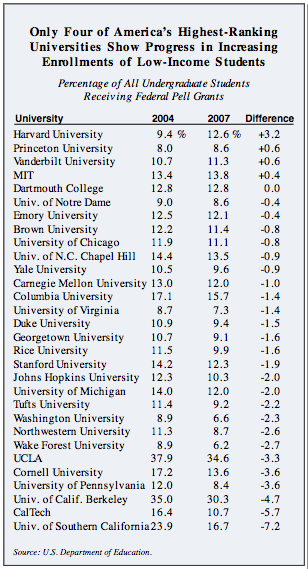|
Disappointing Progress in Enrollments of Low-Income Students at America’s Most Selective Colleges and Universities Over the past three years nearly all of the nation’s highest-ranking colleges and universities have increased their commitment to more financial aid for low-income students. Yet, according to government figures, almost all of these institutions have seen a reduction in low-income students on their campuses. Efforts to make college more affordable are of special and urgent concern to African Americans. The median income of black families in the United States is only 62 percent of the median income of white families. The typical black family holds only one tenth the wealth of the average white family. Blacks are three times as likely as whites to be poor. African Americans are twice as often out of work. Many families use the equity in their home to finance their children’s higher education. But fewer than half of all black families own their home compared to more than three quarters of all white families. Over the years these huge disparities in income and wealth have been a major factor in the extreme differences between the races in enrollments in higher education. Ten years ago Princeton University revolutionized college financial aid in the United States when it decided to provide full-tuition scholarship grants for all students from families with incomes below $40,000 a year. Soon afterward Princeton eliminated loans for all students on financial aid and replaced those loans with scholarship grants. Over the next several years Harvard, the University of Virginia, and the University of North Carolina at Chapel Hill eliminated student loans and greatly increased their financial aid packages for low-income students. This trend of eliminating student loans in favor of scholarship grants and increasing financial aid packages for low- and middle-income students has greatly accelerated over the past three years. Most highly rated universities and colleges have made significant changes to their financial aid programs in order to keep pace with efforts of the most wealthy institutions to attract more low-income students.
Data obtained by JBHE from the U.S. Department of Education bearing on recipients of Pell Grants at high-ranking universities shows that on the whole these educational institutions have had little success in increasing the economic diversity of their student bodies. Pell Grant awards are reserved for students from families typically with incomes below $40,000. Although sometimes flawed or misread, U.S. Department of Education statistics on Pell Grants have become accepted as a standard measure of the percentage and number of low-income students at a particular institution. JBHE’s analysis of the Pell Grant data shows that in the large majority of cases there is, in fact, a smaller percentage of low-income students at these institutions than was the case before the new financial aid programs were put into effect. Only four of the nation’s 30 highest-ranked universities had a larger percentage of low-income students in 2007 than was the case three years earlier in 2004. They are Harvard University, Princeton University, Vanderbilt University, and MIT. At Dartmouth College the percentage of low-income students has remained unchanged. But at 25 of the 30 highest-ranked universities the percentage of the student body that came from low-income families declined from 2004 to 2007. And again, this was in a period when these universities had revamped their financial aid programs to make them more attractive to low-income students.
Now we turn to the performance of the highly selective liberal arts colleges. Among this group Davidson College in North Carolina and Amherst College in Massachusetts led the way by eliminating all student loans and replacing them with scholarship grants. Most of the other leading liberal arts colleges followed by making their financial aid packages more attractive to low-income students. But Pell Grant data obtained by JBHE shows that on the whole these leading liberal arts colleges have not been successful in increasing the economic diversity of their student bodies. JBHE’s analysis shows that despite the introduction of these new financial aid programs, only six of the 30 leading liberal arts colleges have shown an increase in the percentage of low-income students. At Williams College the percentage of the student body that came from low-income families increased from 11.3 percent in 2004 to 13.5 percent in 2007. Amherst College, Colby College, Kenyon College, Barnard College, and Trinity College showed smaller gains. At Bryn Mawr College and Washington and Lee University the percentage of low-income students remained the same during the three-year period. But at 22 of the 30 leading liberal arts colleges the percentage of students from low-income families had declined between 2004 and 2007. The largest drop was at Scripps College in California. There the percentage of low-income students dropped from 13.7 percent to 10.1 percent. Grinnell College, Bucknell University, Mount Holyoke College, Claremont McKenna College, Wellesley College, and Oberlin all saw a drop of more than two percentage points.
Why Low-Income Students Are Not Flocking to These Campuses The standard thesis is that “if you cut the price to zero, the students you want will come.” But JBHE’s data shows that at both the high-ranking universities and the most selective liberal arts colleges this does not hold true. The question is, why? One of the main reasons is that the new financial aid packages targeting low-income students do nothing as such to increase the chances of these students winning admission to these colleges and universities. The money is there for these students if they gain admission, but, on average, students from low-income families are still having difficulty competing for spaces at these institutions. Another factor is that many of our most selective institutions have also beefed up financial aid for middle- and upper-middle-class families. For example, at Harvard University 40 percent of all financial aid recipients come from families with an annual income of more than $100,000. At Harvard, students who come from a family with an annual income of $180,000 are expected to pay only $18,000 of Harvard’s $50,000 annual comprehensive fee. At Yale, students from families with incomes of more than $200,000 are eligible for “need-based” financial aid. As a result, more students from these upper-middle-income families are applying to these selective colleges and universities, and these students tend to have better test scores and grades than students from low-income families. Here are some other factors that make it difficult for high-ranking colleges and universities to attract students from low-income families. • Cultural factors at some universities may dampen the number of applicants from blue-collar or low-income communities. Perceptions of institutional elitism or snobbery are often incorrect. Nevertheless, academically gifted sons or daughters of, say, a steelworker in Detroit may not see an Ivy League college as the right place for them to be. • It is well established that each year many thousands of low-income high school students have sufficiently high SAT scores to meet the requirements of the most selective universities. Yet, on average, low-income students tend to have lower SAT scores than moderate or upper-income students. Always there is a direct correlation between SAT scores and family income levels. This SAT effect tends to restrict the number of qualified applicants from poor families. • Selective colleges are not dedicating sufficient effort to visiting high schools in rural and urban areas. • Even when a student qualifies for enrollment without any payment of tuition, the mere fact that the most selective colleges and universities post fees of almost $50,000 a year for its regular students may produce so-called “sticker shock” that discourages applications from highly qualified students from low-income communities. • Admissions officers at many colleges and universities may not be willing to make necessary adjustments for high potential “late bloomers” in urban or rural high schools for fear of bringing down the mean SAT score of an entering class and thereby eroding the college or university’s U.S. News & World Report ranking for selectivity. • In urban and rural areas and in other low-income communities there may be little or no tradition of sending students to top colleges. High school guidance counselors may steer students with good academic qualifications to state-operated universities and community colleges that post lower costs. The only sure conclusion is that money alone will not do the job to increase the economic diversity on the campuses of our most selective colleges and universities. Particularly, measures such as aggressive recruiting are necessary. University and college admissions officials need to set more extensive plans for personal visits to public high schools in a wide range of working-class communities. |
|




 But the question is, Have these new programs been successful in increasing the number of low-income students on the campuses of our nation’s highest-ranked colleges and universities? A reasonable person would conclude that because these universities have made the cost of higher education more affordable for low-income students, there would be a growing, if not surging, body of low-income students on these campuses. But this is not the case.
But the question is, Have these new programs been successful in increasing the number of low-income students on the campuses of our nation’s highest-ranked colleges and universities? A reasonable person would conclude that because these universities have made the cost of higher education more affordable for low-income students, there would be a growing, if not surging, body of low-income students on these campuses. But this is not the case. Low-Income Students at the Nation’s Highest-Ranked Liberal Arts Colleges
Low-Income Students at the Nation’s Highest-Ranked Liberal Arts Colleges